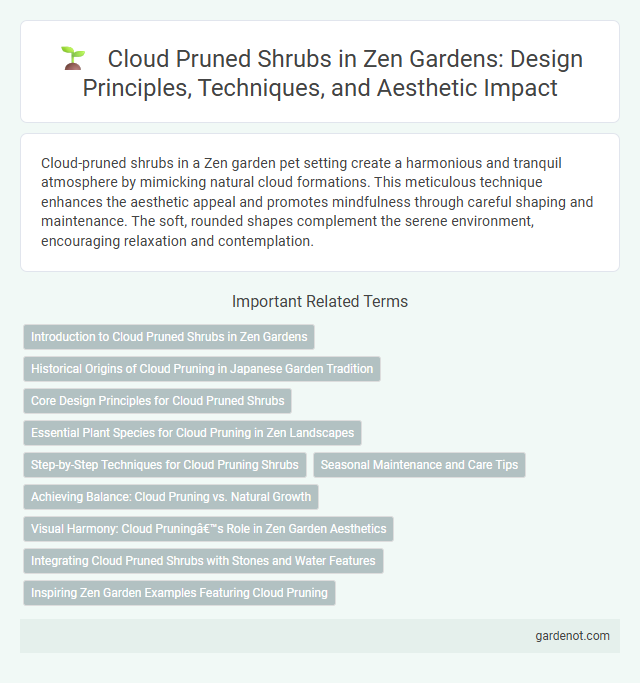Cloud-pruned shrubs in a Zen garden pet setting create a harmonious and tranquil atmosphere by mimicking natural cloud formations. This meticulous technique enhances the aesthetic appeal and promotes mindfulness through careful shaping and maintenance. The soft, rounded shapes complement the serene environment, encouraging relaxation and contemplation.
Introduction to Cloud Pruned Shrubs in Zen Gardens
Cloud pruned shrubs are meticulously shaped plants designed to resemble floating clouds, creating a harmonious balance between nature and artistry in Zen gardens. This traditional Japanese technique emphasizes minimalism and precise pruning to enhance the garden's serene atmosphere. Incorporating cloud pruned shrubs adds depth and visual interest while maintaining the principles of simplicity and tranquility essential to Zen garden design.
Historical Origins of Cloud Pruning in Japanese Garden Tradition
Cloud pruning originated in Japan during the Edo period, reflecting Zen Buddhist principles of simplicity and natural beauty. This horticultural technique shapes shrubs and trees into rounded, cloud-like forms, symbolizing harmony and balance. It emphasizes careful observation and patience, enhancing the meditative atmosphere of traditional Japanese gardens.
Core Design Principles for Cloud Pruned Shrubs
Cloud pruned shrubs embody core design principles such as balance, rhythm, and simplicity, creating a harmonious visual flow reminiscent of natural cloud formations. Emphasizing asymmetrical balance enhances spatial depth, while minimalistic pruning maintains the natural essence of each foliage cluster. Precision in trim lines supports rhythm by guiding the eye through the sculpted layers, reflecting traditional Japanese aesthetics in zen garden landscaping.
Essential Plant Species for Cloud Pruning in Zen Landscapes
Cloud pruned shrubs such as Japanese Boxwood (Buxus microphylla), Nandina domestica (Heavenly Bamboo), and Japanese holly (Ilex crenata) are essential plant species in Zen garden design, offering structured, layered cloud-like forms that enhance tranquility and harmony. These species are prized for their dense foliage and adaptability to meticulous pruning techniques, creating the iconic floating cloud shapes that define Zen landscapes. Selecting resilient evergreens with fine leaves ensures maintenance of the sculptural effect year-round, reinforcing the meditative atmosphere characteristic of traditional Zen gardens.
Step-by-Step Techniques for Cloud Pruning Shrubs
Cloud pruning shrubs involves carefully sculpting foliage into rounded, cloud-like shapes, enhancing the serene aesthetic of Zen gardens. Start by selecting healthy branches and removing any dead or crossing ones to allow better air circulation and light penetration. Use sharp shears to trim new growth into soft, billowy clusters, maintaining balance and rhythm with regular, precise cuts to encourage dense, layered foliage.
Seasonal Maintenance and Care Tips
Cloud pruned shrubs in Zen gardens require precise seasonal maintenance to preserve their sculptural form and promote healthy growth. Regular pruning during late winter or early spring stimulates new shoots, while careful removal of dead or diseased branches prevents pest infestations and ensures optimal air circulation. Consistent watering and mulching during dry months maintain soil moisture, supporting the shrub's vitality and aesthetic balance throughout the year.
Achieving Balance: Cloud Pruning vs. Natural Growth
Cloud pruning sculpts shrubs into layered, rounded shapes that evoke clouds, creating a harmonious Zen garden appearance emphasizing balance and tranquility. This technique contrasts natural growth, which offers organic, unstructured shapes fostering a sense of spontaneity and natural beauty. Combining cloud pruning with sections of natural growth achieves a dynamic balance that enhances the Zen garden's aesthetic and meditative qualities.
Visual Harmony: Cloud Pruning’s Role in Zen Garden Aesthetics
Cloud pruning shapes shrubs into soft, rounded forms that mimic natural clouds, enhancing the visual harmony of Zen gardens. This technique emphasizes balance and simplicity, contributing to the garden's meditative atmosphere. The carefully sculpted clouds create a dynamic interplay of light and shadow, reinforcing Zen principles of tranquility and impermanence.
Integrating Cloud Pruned Shrubs with Stones and Water Features
Cloud pruned shrubs enhance Zen gardens by creating sculptural forms that complement the natural textures of stones and the fluidity of water features, emphasizing harmony and balance. Positioning these shrubs near smooth river rocks or beside reflective ponds highlights their rounded shapes and intricate foliage layers, fostering a tranquil atmosphere. This strategic integration encourages mindful observation and deepens the meditative quality of the garden's design.
Inspiring Zen Garden Examples Featuring Cloud Pruning
Cloud pruning transforms shrubs into soft, rounded shapes that mimic floating clouds, creating serene focal points in Zen gardens. This Japanese horticultural technique enhances spatial harmony and visual balance, emphasizing simplicity and natural beauty. Inspiring Zen garden examples showcase cloud-pruned shrubs integrated with raked gravel and stone arrangements to evoke tranquility and meditative calm.
Cloud pruned shrub Infographic

 gardenot.com
gardenot.com